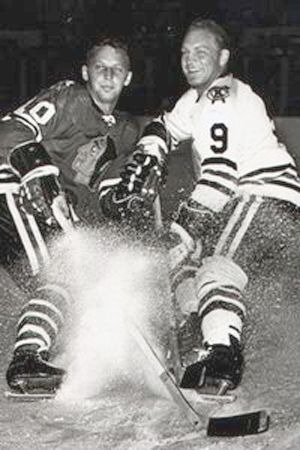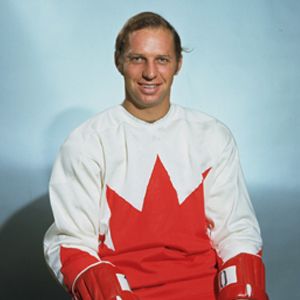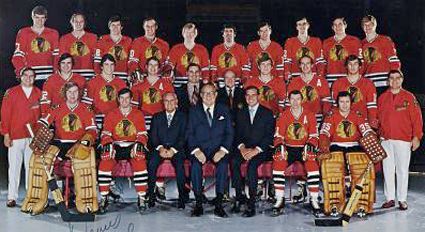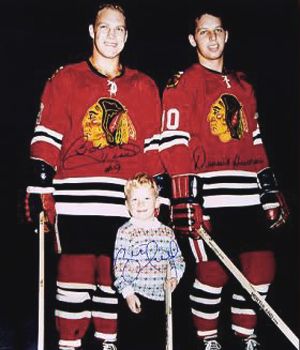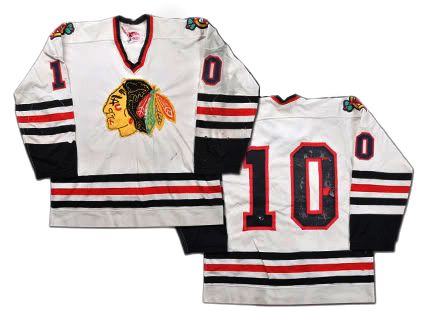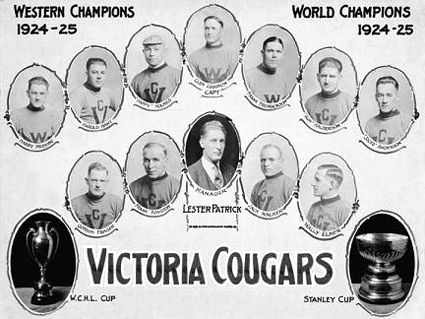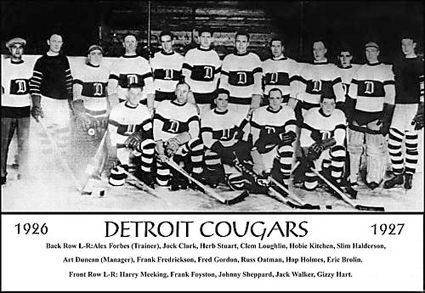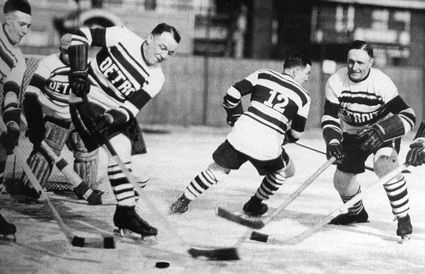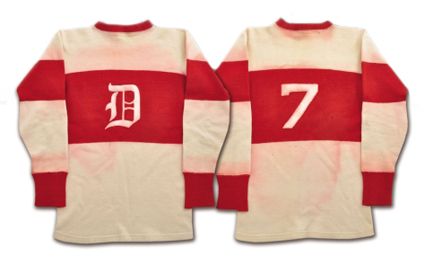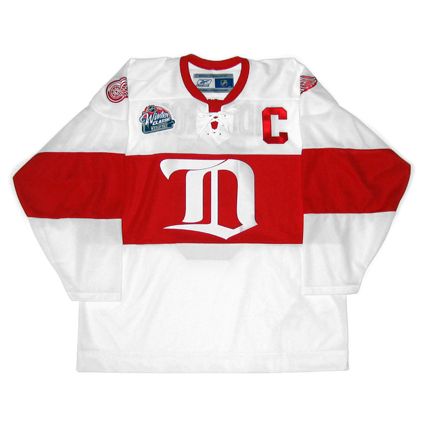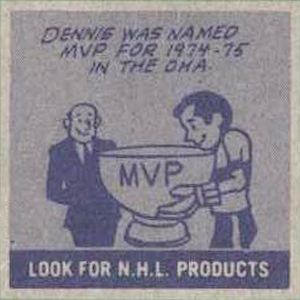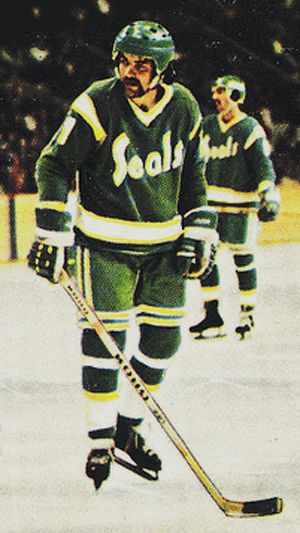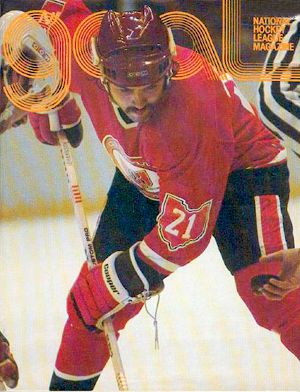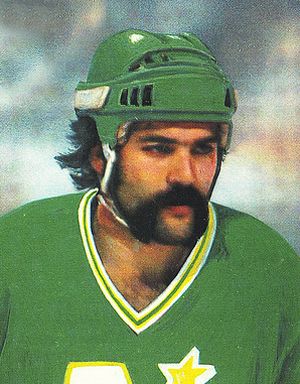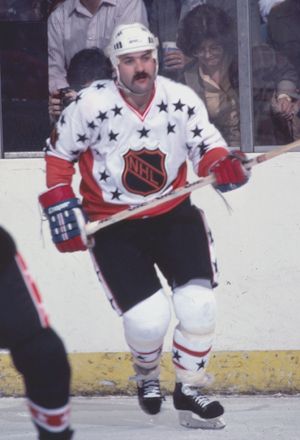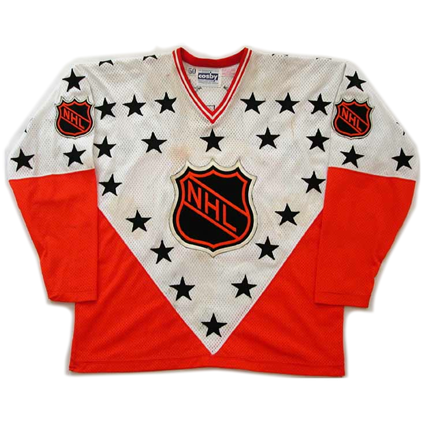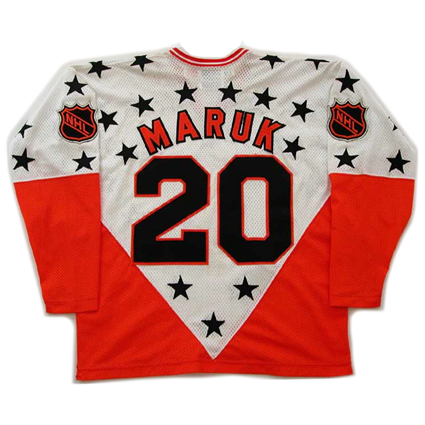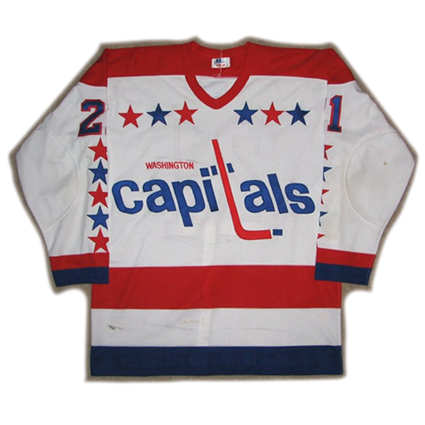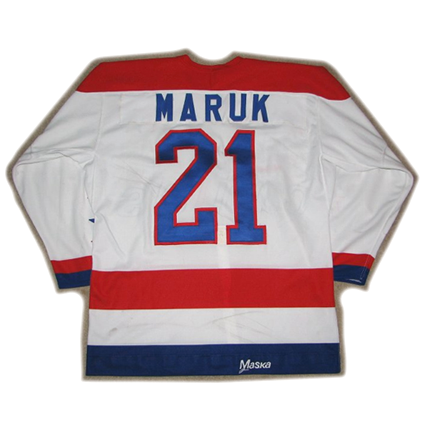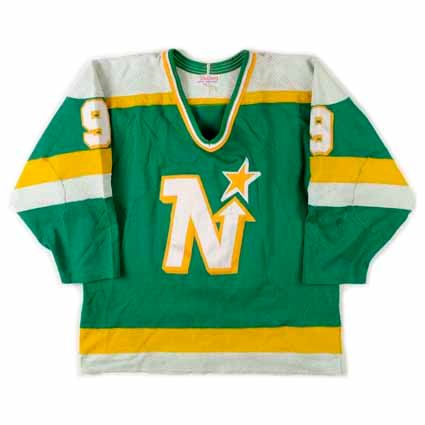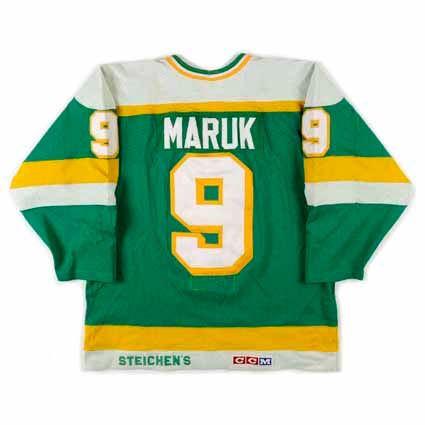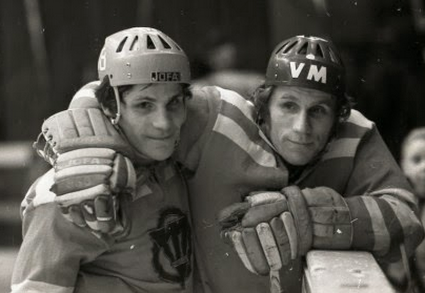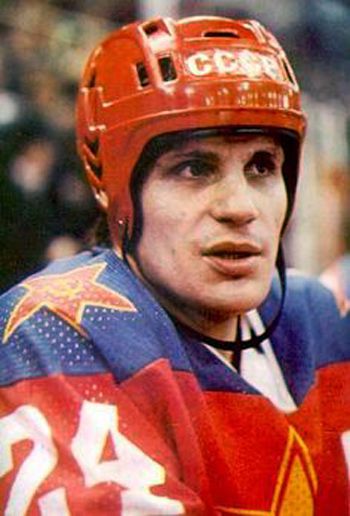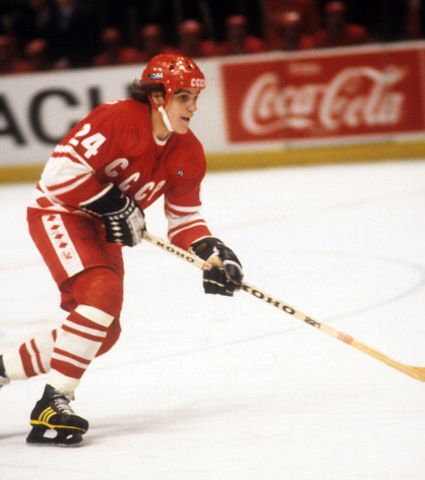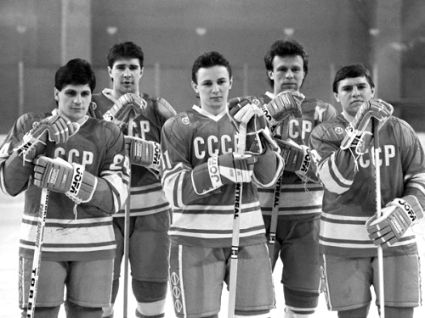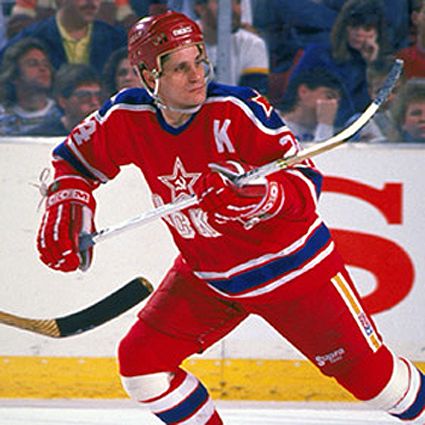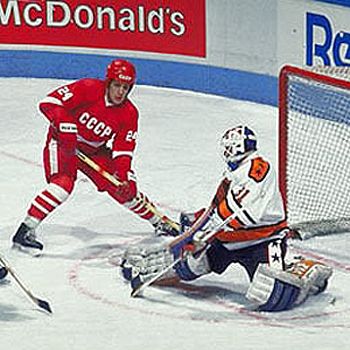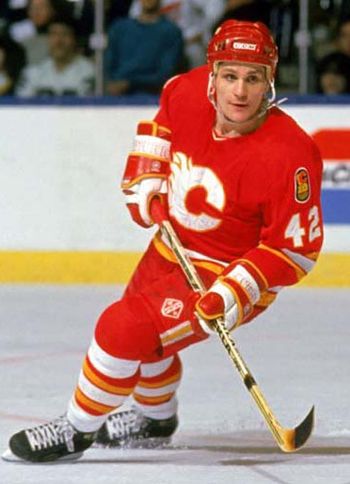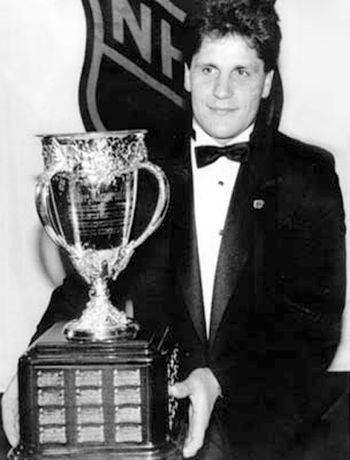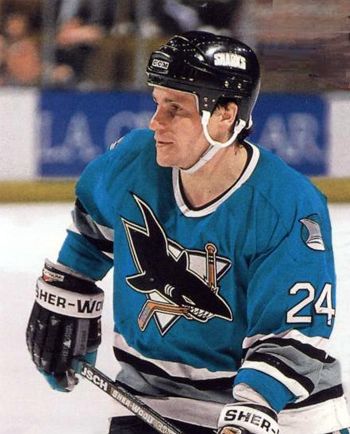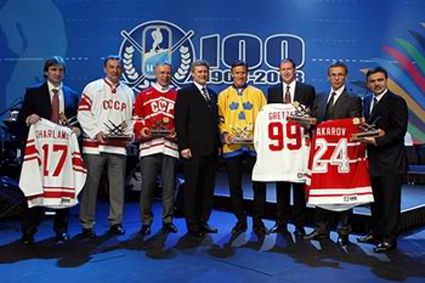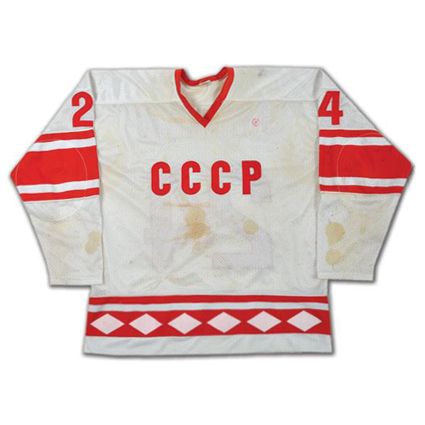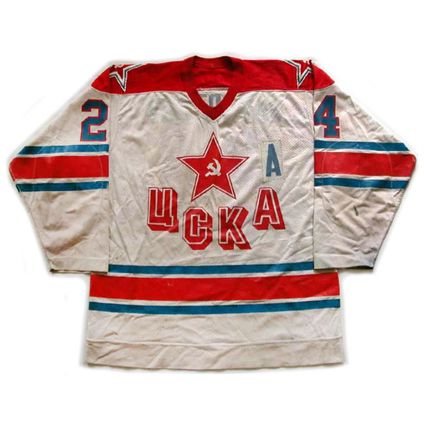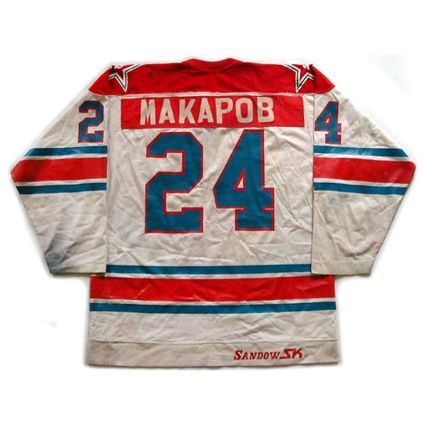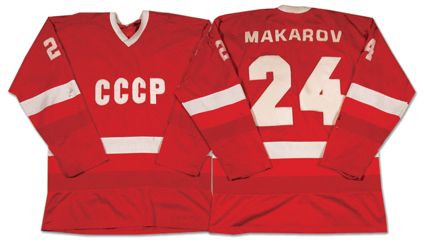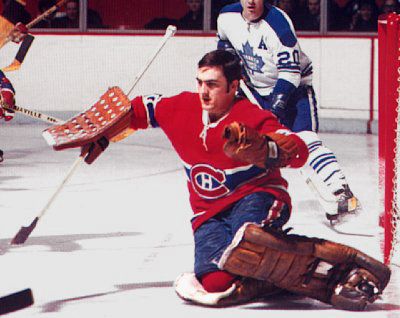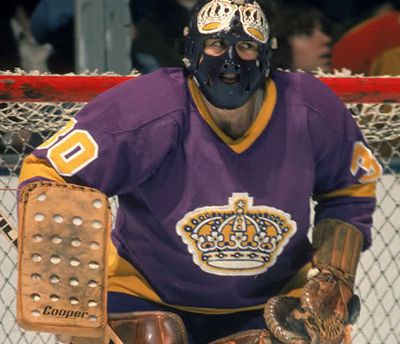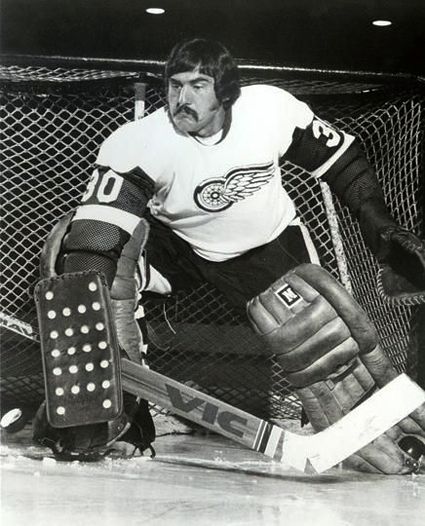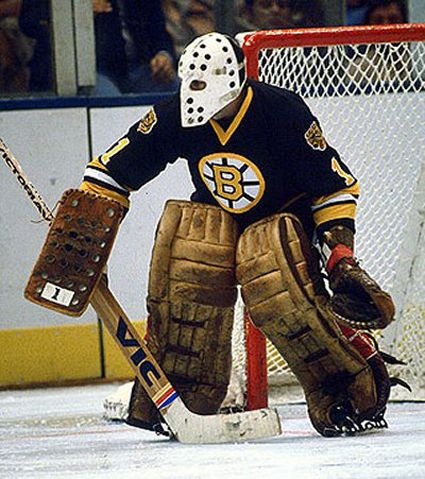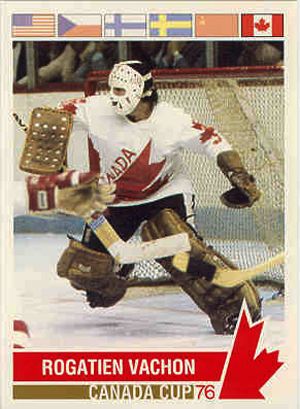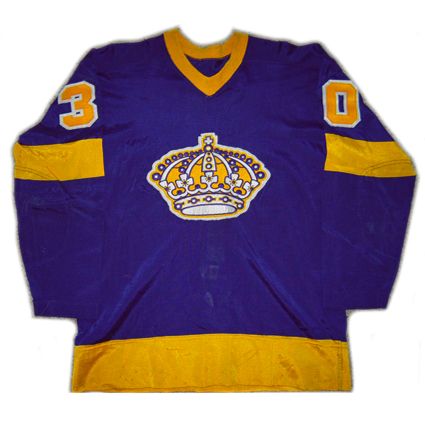home white Black Hawks jerseys
Saturday, November 19, 2016
1972-73 Chicago Black Hawks Dennis Hull Jersey
Playing his career in the shadow of his older brother and teammate Bobby Hull, Dennis Hull was born on this date in 1944.
Dennis and Bobby Hull
Hull played junior hockey with the St. Catharines Teepees of the Ontario Hockey League beginning in the 1960-61 season and gave no indication of what was to follow with two seasons of 10 and 18 points. The team became sponsored by the Chicago Black Hawks in 1962 and thus became the St. Catharines Black Hawks. In 1962-63 Hull raised his point total to 48 before impressing the following season with 48 goals and 97 points, doubling his total from the previous season.
He made the Chicago roster in 1964-65 and saw action in 55 games, scoring 10 goals as a rookie. The club determined he needed some additional seasoning in 1965-66, and Hull was sent to the minors for 40 games with the St. Louis Braves. He also played 25 games with Chicago that season, but his lone goal raised cause for concern.
Those fears were calmed in 1966-67 when he played in all 70 games, scoring 25 goals and 42 points. Two seasons later Hull registered his first 30 goal season. The only problem for Dennis was that Bobby was in his 12th season for the Black Hawks, had ten seasons of 30 goals or more and scored an NHL record 58 goals that same season. Such was life for Dennis Hull in the NHL.
Dennis in the road red and Bobby Hull in the
home white Black Hawks jerseys
home white Black Hawks jerseys
Dennis had a very good 1970-71 season, setting a career high in goals with 40 and nearly catching Bobby, who had 44 while now having been paired with Pit Martin and Jim Pappin on the "MPH Line", which came from the trio's last initials. The team also excelled, making a playoff run that would take them to the first Stanley Cup Finals in Dennis' career.
Dennis spent 13 seasons with the Black Hawks
For their final season as teammates, Dennis had his third 30 goal season and set a new personal best with 69 points. For 1972-73, the hockey world was turned on it's ear with the arrival of the World Hockey Association, who made Bobby their marquee attraction by signing him away from the Black Hawks by virtue of a million dollar contract.
This defection resulted in Bobby being blacklisted from the Team Canada roster for the 1972 Summit Series against the Soviet Union, despite his undoubted offensive capabilities. Dennis though, was still a member of the NHL and became part of Team Canada, at the urging of his brother following Dennis' thoughts of boycotting the series in support of Bobby. Dennis was paired with New York Ranger teammates Jean Ratelle and Rod Gilbert, and scored two goals and four points in the four games he played in.
Dennis in a 1972 Team Canada jersey
With the 50 goal scorer Bobby now out of the lineup, everyone feared what the impact would be on the Black Hawks, but the MPH Line stepped up to fill the void, and all three players hitting at least 90 points and raising their previous season total by a minimum of 21 which saw Dennis Hull score 39 goals and set a career high with 90 points. That season, Chicago would again return to the Stanley Cup Finals for the second time in Hull's career.
The 1972-73 Chicago Blackhawks
In 1973-74, Hull would play in 74 games, his eighth consecutive season of 70 games or more, a streak broken the following season when he played in "just" 69 games. He followed that with playing 80 and then 75 in his final two seasons with the Black Hawks. In all, he would play 824 games out of a possible 848 games once he established himself as a regular with the club 11 seasons earlier, a rate of 97% for the model of reliability and consistency he, and the MPH Line, provided the Black Hawks.
Hull was acquired by the Detroit Red Wings for the 1977-78 season, his final one before retiring as a player.
His final NHL totals are 959 games played with 3030 goals and 351 assists for 654 points and he would appear in six NHL All-Star Games, including the 1974 version with linemates Martin and Pappin.
Known for his outgoing personality and sense of humor, he wrote a book entitled (in reference to his nephew and Bobby's offensively gifted son Brett Hull) "The Third Best Hull - I would have been fourth best but they wouldn't let my sister Maxine play."
Bobby, Brett and Dennis Hull
Today's featured jersey is a 1972-73 Chicago Black Hawks Dennis Hull jersey as worn during Hull's career year when he played for Team Canada in the 1972 Summit Series and then went on to the best season of his NHL career with 90 points.
The Black Hawks adopted this jersey style in 1955 and it has become an icon in the world of hockey, remaining essentially unchanged for over 55 years.
Hull has gone on to a career as a public and motivational speaker, and here he is telling some of his humorous stories.
Here are highlights of Game 6 of the 1972 Summit Series, in which Hulls scores a goal for Team Canada.
Finally, a pair of intertwined interviews from WGN TV in Chicago, hosted by long time Cubs announcer Jack Brickhouse. Bobby clearly got the better background for his interview...
Labels:
Chicago Blackhawks,
Hull Dennis
Friday, November 18, 2016
1926-27 Detroit Cougars Russell Oatman Jersey
It was on this date in 1926 that the Detroit Cougars would play in their first NHL game, losing 2-0 to the Boston Bruins at the Border Cities Arena in Windsor, Ontario where the Cougars would play their home games during their first season since they had no home arena in Detroit at the time.
Our video section begins with a preview of the 2009 Winter Classic, during which the Red Wings wore jerseys inspired by the original Cougars jerseys.
When the Western Canada Hockey League folded after the 1925-26 season, a deal was made so the new Detroit expansion NHL club bought the rights to the players of one of the most successful of the WCHL teams, the 1925 Stanley Cup champion Victoria Cougars.
The new Detroit club was named the Cougars in honor of the Victoria club from where it's roster originated. The Cougars played a 44 game schedule, finishing last in the American Division of the 10 team league with a 12-28-4 record. John Sheppard would lead the team in scoring with 21 points in 43 games.
For the following season of 1927-28, the Detroit Olympia would become the Cougars new home, where they would play for the next 52 years, until December of 1979. That same season, Jack Adams would take over as coach in Detroit and spend the next 36 years as either the coach or general manager of the club. The Cougars would finish the season with a 19-19-6 record for fourth place in the American Division. George Hay would lead the team with 35 points in 42 games, tied for third in the league.
he 1928-29 Cougars would finish with a similar 19-16-9 record but make the Stanley Cup playoffs for the first time, losing out to the Toronto Maple Leafs 7-2 in a two game total goals series. Carson Cooper would lead the Cougars in scoring with 27 points in 43 games to finish third in the league.
The final season for the name Cougars, 1929-30, would see Detroit post a 14-24-5 record and miss out on the playoffs. Cooper would again lead the team in scoring, this time with 36 points in 44 games played.
Before the start of the next season, the Detroit club would change it's name from its original choice of Cougars to Falcons, bringing an end to the first era of of the franchise and hoping to change it's luck. The name Falcons would last but two seasons until a change in ownership led to the adaptation of the Red Wings name.
Today's featured jersey is a 1926-27 Detroit Cougars Russell Oatman jersey worn by the expansion Cougars during their first season in the NHL. The Cougars name lasted just four seasons, but the team wore a new style sweater for every one of those four years, offering no clues as to what was to come, as the Red Wings name was introduced in 1932 and their red jerseys have now remained unchanged for over 80 years!
Before the start of the next season, the Detroit club would change it's name from its original choice of Cougars to Falcons, bringing an end to the first era of of the franchise and hoping to change it's luck. The name Falcons would last but two seasons until a change in ownership led to the adaptation of the Red Wings name.
Today's featured jersey is a 1926-27 Detroit Cougars Russell Oatman jersey worn by the expansion Cougars during their first season in the NHL. The Cougars name lasted just four seasons, but the team wore a new style sweater for every one of those four years, offering no clues as to what was to come, as the Red Wings name was introduced in 1932 and their red jerseys have now remained unchanged for over 80 years!
Bonus jersey: Today's bonus jersey is a 2008-09 Detroit Red Wings Nicklas Lidström jersey worn for the Winter Classic on January 1, 2009 at Wrigley Field in Chicago when the Red Wings defeated the Chicago Blackhawks 6-4. This jersey is based on the style that Detroit wore in during the franchise's first season of 1926-27 when they were known by their original name of the Detroit Cougars.
Thursday, November 17, 2016
1982 NHL All-Star Dennis Maruk Jersey
Born on this date in 1955, Dennis Maruk caught the attention of NHL scouts while playing junior hockey for the London Knights of the Ontario Hockey Association. As a rookie, Maruk scored 46 goals and 113 points in 1972-73 to break Marcel Dionne's league rookie scoring record , led the club in scoring the next season with 47 goals and 112 points before finishing third overall with 66 goals and 145 points in 65 games, an average of a goal every game and 2.23 points every time he took the ice.
Informative Dennis Maruk hockey card trivia
Following that season Maruk was selected 21st in the second round by the California Golden Seals of the NHL as well as being taken 65th overall by the Cleveland Crusaders of the WHA, his relatively low draft positions being due to his smaller size, as Maruk was 5' 8" and 165 pounds. He chose to sign with California and immediately stepped into the Golden Seals lineup, playing all 80 games of the 1975-76 season. He would score 30 goals finish second in team scoring, just one back of Al MacAdam with 62 points.
Maruk with the Golden Seals during the black skates era
That would prove to be the troubled Golden Seals final season in Oakland, and the club relocated to Cleveland, Ohio where they were renamed the Barons for the 1976-77 season. He led the Barons in scoring with 78 points their first season in Cleveland and again in 1977-78 with 36 goals and 71 points, 20 more than his next closest teammate which earned him his first NHL All-Star appearance.
Maruk with the Barons in 1976-77 when they had
the State of Ohio patches on the arms
the State of Ohio patches on the arms
For the 1978-79 season, the lowly Barons were merged with the even worse Minnesota North Stars, resulting in Maruk's third club in four seasons despite never having been traded or waived!
Often overlooked, Maruk had one of the finest mustaches in NHL history
Despite his obvious offensive talents, Minnesota would deal Maruk to the Washington Capitals after just two games in the green and gold, a decision Maruk would make Minnesota regret.
Maruk immediately led the Capitals in scoring with a 31 goal 90 point season. Torn knee ligaments ruined his 1979-80 season, limiting him to just 27 games after not playing less than 76 in any previous season.
He returned healthy and with a vengeance, playing all 80 games for the next three consecutive seasons while scoring 50 goals for the first time in 1980-81, good for eight in the league.
Maruk had 50 and 60 goal seasons with Washington
The 1981-82 season was a career year for Maruk, as he again led the Capitals in scoring with 60 goals (third in the league) and 76 assists for 136 points, which was fourth overall. His efforts were recognized with his second NHL All-Star Game appearance. Despite his career statistical highs, the Capitals and Maruk missed the playoffs yet again. Maruk's 76 assists and 136 points remain the Captials team records to this day.
Maruk played in the NHL All-Star Game in 1978 and 1982
While his personal scoring declined to 31 goals and 81 points, the Capitals qualified for the postseason for the first time in their history. It would also be the first time Maruk would participate in a playoff game in his now eight year career.
Maruk was not to be a part of the Capitals future however, as perhaps wishing they had been the benefactors of his 50 and 60 goal seasons, the North Stars reacquired Maruk for the 1983-84 season. A combination of getting older and the North Star style of play limited Maruk's offensive output, and Maruk would never again approach his electrifying point totals from his days in Washington.
His first four seasons in Minnesota were a model of consistency, as he would play in 71, 71 and 70 games, scoring 60, 60 and 58 points. One tradeoff for the lower scoring totals was that Minnesota qualified for the playoffs all three seasons, including a run to the semifinals in 1984.
Maruk returned to Minnesota in 1983 for his final six seasons
Injuries began to take their toll on the normally healthy Maruk, and a separated shoulder and torn knee ligaments cut his 1986-87 season to 67 games and 46 points. The following season was more of the same, as he missed the start of the schedule with a lacerated tendon and sara his season end early with a shattered knee cap. He would see the ice for just 22 games that season.
The surgery required on his knee would affect his 1988-89 season, and he would eventually play just 5 games in the minors and 6 with the North Stars before retiring from the NHL for good.
Maruk's final career totals are 888 games played, 356 goals and 522 assists for 878 points.
Outside of his NHL career, Maruk also participated in the World Championships for Canada on four occasions, in 1978 winning a bronze medal, 1979, 1981 and 1983 when he brought home a second bronze.
Today's featured jersey is a 1982 NHL All-Star Game Dennis Maruk jersey. This gaudy one year only style is the most absurd of all the 1980's All-Star jerseys with it's excessive number of stars, proving quite visually that less is sometimes more.
Apparently the design team did not get the word that the disco era had ended. In addition to having far too many stars, the NHL logos on the arms would have been better served by being on the shoulders to leave room for sleeve numbers.
Fortunately sanity would prevail and the next ten years would see some of the best jerseys in the history of the All-Star Game.
Bonus jersey: Today's bonus jersey is a 1981-82 Washington Capitals Dennis Maruk jersey, proving by comparison that less stars can be more effective.
This jersey was worn during Maruk's 60 goal season and can be distinguished by the Maska logo on the back, which was closer to the side of the jersey in previous years. Additionally, the word Washington on the front is much smaller than it was in 1979-80.
Extra bonus jersey: Today's extra bonus jersey is a 1984-85 Minnesota North Stars Dennis Maruk jersey, proving by comparison that perhaps a minimalist approach to stars can be even more effective!
This style of North Stars jersey was first worn in 1978-79, and while the white jerseys had bold black trim added to them in 1981-82, the green jerseys remained unchanged for an additional seven seasons before, they too, had the black trim added in 1988-89 for just two seasons until the team's entire look was reworked under new ownership.
In comparison to the constellation of starts on the 1982 NHL All-Star jerseys or even the 16 stars on a Capitals jersey, which essentially act as stripes, the North Stars showed great restraint had simply one star, an italicized and drop shadowed star atop the N crest, which conveyed action and speed on what still remains today as a highly popular jersey.
Today's video segment begins with a tribute to Maruk on the occasion of his entering the Etobicoke Sports Hall of Fame in 2004.
This style of North Stars jersey was first worn in 1978-79, and while the white jerseys had bold black trim added to them in 1981-82, the green jerseys remained unchanged for an additional seven seasons before, they too, had the black trim added in 1988-89 for just two seasons until the team's entire look was reworked under new ownership.
In comparison to the constellation of starts on the 1982 NHL All-Star jerseys or even the 16 stars on a Capitals jersey, which essentially act as stripes, the North Stars showed great restraint had simply one star, an italicized and drop shadowed star atop the N crest, which conveyed action and speed on what still remains today as a highly popular jersey.
Today's video segment begins with a tribute to Maruk on the occasion of his entering the Etobicoke Sports Hall of Fame in 2004.
Speaking of gaudy jerseys, here is some rare footage of Maruk while wearing Canada's loudest design ever at the 1978 World Championships against the Soviet Union.
Looking great, but sans mustache, Maruk is interviewed at the 2009 Canadian Pond Hockey Championships.
Wednesday, November 16, 2016
1981 Soviet Union National Team Sergei Makarov Jersey
On Monday night, Sergei Makarov became the seventh Russian inducted into the Hockey Hall of Fame joining Vladislav Tretiak (1989), Viacheslav Fetisov (2001), Valeri Kharlamov (2005), Igor Larionov (2008), Pavel Bure (2012) and Sergei Fedorov (2015).
Super extra bonus jersey: Today's super extra bonus jersey is a 1990-91 Calgary Flames Sergei Makarov jersey. Makarov was among the first wave of star players allowed to leave the Soviet Union to play professionally in the NHL and made an immediate impact, winning the NHL Rookie of the Year award after leading the Flames in scoring in 1989-90.
The Flames moved to Calgary in 1980-81 and retained the same jerseys they wore in Atlanta, only with the flaming A crest updated to a flaming C. This style jersey would remain in use through the 1993-94 season.
Makarov began his career in the Soviet Championship League with Traktor Chelyabinsk in the 1976-77 season, appearing in 11 games and scoring one goal, which gave little clue as to what would follow.
Still, his potential was recognized and he was named to the Soviet Union World Junior squad for the 1977 Soviet World Junior Team where he won a gold medal and finished second in team scoring with 4 goals and 8 points in 7 games.
He then proceeded to impress during his second and final season in Cheylabinsk with 18 goals and 31 points in 36 games to lead Traktor in scoring while finishing in the top ten in league scoring as an 19 year old. His international resume grew with a second gold medal at the World Juniors where the right winger finished third in tournament scoring with 8 goals and 15 points in 7 games. Later that spring, Makarov played in his first World Championships for the Soviet Union, debuting with 3 goals and 5 points in 10 games while earning another gold medal, his third before his 20th birthday.
As was the way in the world of Soviet hockey, Makarov's potential and scoring exploits caught the attention of the powers that be at the Soviet Red Army club, and he soon found himself as a member of the Soviet military, assigned to duty as a hockey player for CSKA Moscow for the 1978-79 season, playing with illustrious teammates such as Vladimir Petrov, Boris Mikhailov, Kharlamov and future linemate Vladimir Krutov as well as defensemen Fetisov and Alexei Kasatonov.
Makarov fit right into the high powered Red Army lineup, totaling 18 goals and 39 points in his first season in Moscow, which concluded with the first of 11 consecutive Soviet Championship League titles for Makarov in Moscow. No longer eligible for the World Juniors, Makarov would have to settle for a lone gold medal in 1979, as the Soviets won the World Championship at home in Moscow where Makarov had 8 goals and 12 points in 8 games. Additionally, Makarov was a member of the Soviet Union National Team who defeated a team of NHL All-Stars in the 1979 Challenge Cup in Madison Square Garden in New York.
His offensive game took a quantum leap upward in 1979-80, as he led the league in scoring with 68 points in 44 games on his way to being named the Soviet MVP in 1980. He also made his Olympic debut that year, returning home with a silver medal from Lake Placid, New York.
Makarov was again the Soviet scoring champion in 1981 thanks to a 42 goal, 79 point season, which proved to be his career high while competing in the Soviet Union. He was also back to his gold medal winning ways, as the Soviets won the 1981 World Championship in the spring and then claimed the Canada Cup in the fall of that same year with Makarov chipping in 9 points in 7 games.
He completed a hat trick of league scoring titles in 1982 after a 32 goal, 75 point season before leading the Soviets in scoring at the 1982 World Championships, which added another gold medal to his collection. Also, 1981-82 was the season Larionov would finally arrive in Moscow from Khimik Voskresensk, which led to the formation of both the famed KLM line with both Makarov and Krutov as well as the Green Unit, with defensemen Fetisov and Kasatonov to complete the legendary five man group.
He was limited to just 30 games of the 1982-83 season, which put an end to his run of league scoring titles, but he recovered from his injury in time to capture another World Championship following a dominant 9 goal, 18 point performance in 10 games for his fifth gold in five tries.
Makarov then went on a run of dominance that would see him lead the league in scoring for six consecutive seasons from 1984 through 1989, highlighted by a 36 goal, 73 point season in 1983-84. During that time period he would win his second and third Soviet MVP awards in 1985 and 1989.
Internationally, 1984 would see him win his first Olympic gold medal, a disappointing bronze at the 1985 World Championships despite his leading the tournament in scoring, a return to gold in 1986 where he again led all scorers in points, a sliver at the 1987 Worlds, a second Olympic gold in 1988 and a return to gold at the World Championships in 1989.
Makarov would win a second Olympic gold medal in 1988
Makarov's run of Soviet Championships, league scoring titles the KLM line and the Green Unit came to an abrupt end when he, Fetisov, Larionov Kasatonov and Krutov became the first wave of Soviet players allowed to join the NHL following Larionov's open letter of protest of the way they players were treated. Makarov was able to join the defending Stanley Cup champion Calgary Flames, who had drafted him back in 1983 in hopes that he would some day be allowed to leave the Soviet Union.
His talent translated well to the North American game, as he set a career highs with 62 assists and 86 points in his rookie season, thanks no doubt to the much longer NHL schedule of games, 80 versus no more than 50 in the Soviet Union. He was controversially named the winner of the Calder Trophy as the NHL Rookie of the Year at the age of 31, which led to the "Makarov Rule" limiting the award to players under the age of 26.
He followed with two more seasons of 70 points or more and after a fourth season in Calgary, Makarov was dealt to the Hartford Whalers in June of 1993 only to be sent to the San Jose Sharks in August prior to the start of the 1993-94 season, where he was reunited with Larionov and led the third year Sharks in scoring with 30 goals and 68 points.
With the Flames early playoff exits in 1990 and 1991, Makarov made two final international appearances for the Soviet Union, winning gold in 1990 and a bronze in 1991 at the World Championships.
Makarov was limited to 43 games in 1994-95, seemingly brining a close to his playing days at age 37, as he then turned to coaching. He did make a brief comeback attempt in 1996-97, playing four games with the Dallas Stars and then six games with HC Fribourg-Gottéron in Switzerland before retiring for good.
Makarov's final totals show 11 Soviet championships, two Soviet Cups, 11 European Champions Cups, three Soviet MVP awards, nine Soviet scoring titles, the Calder Trophy, a Canada Cup, the 1979 Challenge Cup, two World Junior golds, eight gold, one silver and two bronze medals at the World Championships and a silver and two gold Olympic medals. He is the all-time leading scorer for the Soviet Union with 248 total points, with only Alexsandr Maltsev having more scored more than 200.
His Soviet scoring totals are 322 goals and 710 points with an additonal 134 goals and 384 points while in the NHL. In 2001, Makarov was inducted into the IIHF Hall of Fame and then in 2008 received the ultimate honor of being named to the prestigious IIHF Centennial All-Star Team, which was limited to only the best six players in the last 100 years, one at each position.
Today's featured jersey is a 1981 Soviet Union National Team Sergei Makarov jersey. In September of 1976, the Soviet Union debuted a new set of sweaters decorated with repeating diamond shapes around the waist - a radical departure for the Soviets. This style would serve the them well, including several tours of North America in the Super Series games against NHL clubs, the 1976 Canada Cup, the 1979 Challenge Cup, the 1980 Olympics, the 1981 Canada Cup and another tour of North America in 1983.
Makarov made his NHL debut with the Calgary Flames in 1989
His talent translated well to the North American game, as he set a career highs with 62 assists and 86 points in his rookie season, thanks no doubt to the much longer NHL schedule of games, 80 versus no more than 50 in the Soviet Union. He was controversially named the winner of the Calder Trophy as the NHL Rookie of the Year at the age of 31, which led to the "Makarov Rule" limiting the award to players under the age of 26.
31 year old Makarov with the Calder Trophy
as NHL "Rookie" of the Year
He followed with two more seasons of 70 points or more and after a fourth season in Calgary, Makarov was dealt to the Hartford Whalers in June of 1993 only to be sent to the San Jose Sharks in August prior to the start of the 1993-94 season, where he was reunited with Larionov and led the third year Sharks in scoring with 30 goals and 68 points.
Makarov's second 30 goal NHL season came with the Sharks in 1993-94
With the Flames early playoff exits in 1990 and 1991, Makarov made two final international appearances for the Soviet Union, winning gold in 1990 and a bronze in 1991 at the World Championships.
Makarov was limited to 43 games in 1994-95, seemingly brining a close to his playing days at age 37, as he then turned to coaching. He did make a brief comeback attempt in 1996-97, playing four games with the Dallas Stars and then six games with HC Fribourg-Gottéron in Switzerland before retiring for good.
Makarov's final totals show 11 Soviet championships, two Soviet Cups, 11 European Champions Cups, three Soviet MVP awards, nine Soviet scoring titles, the Calder Trophy, a Canada Cup, the 1979 Challenge Cup, two World Junior golds, eight gold, one silver and two bronze medals at the World Championships and a silver and two gold Olympic medals. He is the all-time leading scorer for the Soviet Union with 248 total points, with only Alexsandr Maltsev having more scored more than 200.
His Soviet scoring totals are 322 goals and 710 points with an additonal 134 goals and 384 points while in the NHL. In 2001, Makarov was inducted into the IIHF Hall of Fame and then in 2008 received the ultimate honor of being named to the prestigious IIHF Centennial All-Star Team, which was limited to only the best six players in the last 100 years, one at each position.
The IIHF Centennial All-Star Team, Kharlamov, Tretiak, Fetisov,
Borje Salming, Wayne Gretzky and Makarov
Borje Salming, Wayne Gretzky and Makarov
Today's featured jersey is a 1981 Soviet Union National Team Sergei Makarov jersey. In September of 1976, the Soviet Union debuted a new set of sweaters decorated with repeating diamond shapes around the waist - a radical departure for the Soviets. This style would serve the them well, including several tours of North America in the Super Series games against NHL clubs, the 1976 Canada Cup, the 1979 Challenge Cup, the 1980 Olympics, the 1981 Canada Cup and another tour of North America in 1983.
While the Soviet Union was used to having it's way at the World Championships and the Olympics, the Canada Cup was the one time where each country could send it's best players regardless of their amateur or professional status, which benefited Canada more than any other country.
The Soviet Union had opened it's tournament with a 1-1 tie against their rivals from Czechoslovakia and received a sound 7-3 thumping at the hands of Canada in the Round Robin portion of the tournament, knowing that both countries had already qualified for the playoffs. The Soviets then downed the Czechs 4-1 in the Semifinals and stunned Canada 8-1 in the finals, scoring the last seven goals of the contest after the game was tied at 1-1 eight minutes into the second period. Makarov would finish the final with two assists, including one on Larionov's opening goal of the game at the five minute mark of the second period.
photo courtesy of Classic Auctions
Bonus jersey: Today's bonus jersey is a 1979-80 Soviet Central Red Army Sergei Makarov jersey as worn by Makarov during the season he would lead the league in scoring for the first of nine times in ten seasons as well as being named the league MVP for the first of three times.
This jersey has a few details of note, as it was manufactured by a Canadian company, Sandow SK, and it's nameplate and numbers are sewn on, as opposed to the common 1980's Soviet practice of screen printing with thick ink. Also, the assistant captain's "A" appears to be dye-sublimated onto it's own "mini-nameplate", which was then sewn onto the jersey, and at a somewhat haphazard angle, rather than a letter being sewn directly to the jersey, a method often seen in Europe but rarely in North America.
Due to it's Canadian manufacturing, it's probable that this jersey was made for the 1979-80 Red Army tour of North America as a part of the "Super Series" of exhibition games against NHL club teams and then brought back for use during the Soviet league regular season after the addition of a Cyrillic nameplate. Sharp-eyed readers will notice the blue letters on the back showing through the neck hole, which has been covered up by the red nameplate when viewed from the back, which shows this particular jersey has been recycled from another player, a common practice in the latter days of the Soviet Union when resources such as hockey equipment were stretched thin at times.
Extra bonus jersey: Today's extra bonus jersey is a 1987 Soviet Union National Team Sergei Makarov jersey as worn by Makarov during Rendez-vous '87, a two-game series held in Quebec City on February 11 and 13, 1987 which replaced that season's traditional NHL All-Star Game and featured a team of NHL All-Stars against the Soviet National Team.
This jersey has a few details of note, as it was manufactured by a Canadian company, Sandow SK, and it's nameplate and numbers are sewn on, as opposed to the common 1980's Soviet practice of screen printing with thick ink. Also, the assistant captain's "A" appears to be dye-sublimated onto it's own "mini-nameplate", which was then sewn onto the jersey, and at a somewhat haphazard angle, rather than a letter being sewn directly to the jersey, a method often seen in Europe but rarely in North America.
Due to it's Canadian manufacturing, it's probable that this jersey was made for the 1979-80 Red Army tour of North America as a part of the "Super Series" of exhibition games against NHL club teams and then brought back for use during the Soviet league regular season after the addition of a Cyrillic nameplate. Sharp-eyed readers will notice the blue letters on the back showing through the neck hole, which has been covered up by the red nameplate when viewed from the back, which shows this particular jersey has been recycled from another player, a common practice in the latter days of the Soviet Union when resources such as hockey equipment were stretched thin at times.
Extra bonus jersey: Today's extra bonus jersey is a 1987 Soviet Union National Team Sergei Makarov jersey as worn by Makarov during Rendez-vous '87, a two-game series held in Quebec City on February 11 and 13, 1987 which replaced that season's traditional NHL All-Star Game and featured a team of NHL All-Stars against the Soviet National Team.
This jersey is typical of the Soviet style, with a minimum of adornments and simple one color names and numbers, made to look even more spartan when compared to the flashy NHL All-Star jerseys it competed against.
This style made its debut at the 1984 Olympics and was worn again later that year for the 1984 Canada Cup. Although the Soviets wore a series of flashier Adidas jerseys from 1985 through the 1987 Canada Cup, this style made a single encore return for Rendez-vous '87 in February against a team of NHL All-Stars.
This style made its debut at the 1984 Olympics and was worn again later that year for the 1984 Canada Cup. Although the Soviets wore a series of flashier Adidas jerseys from 1985 through the 1987 Canada Cup, this style made a single encore return for Rendez-vous '87 in February against a team of NHL All-Stars.
photo courtesy of Classic Auctions
Super extra bonus jersey: Today's super extra bonus jersey is a 1990-91 Calgary Flames Sergei Makarov jersey. Makarov was among the first wave of star players allowed to leave the Soviet Union to play professionally in the NHL and made an immediate impact, winning the NHL Rookie of the Year award after leading the Flames in scoring in 1989-90.
The Flames moved to Calgary in 1980-81 and retained the same jerseys they wore in Atlanta, only with the flaming A crest updated to a flaming C. This style jersey would remain in use through the 1993-94 season.
photo courtesy of Classic Auctions
Today's video section begins with a look at the sublime talents of Makarov.
Next, Makarov and the Green Unit score a goal in Game 3 of the 1987 Canada Cup.
Next, Makarov and the Green Unit score a goal in Game 3 of the 1987 Canada Cup.
Tuesday, November 15, 2016
1971-72 Los Angeles Kings Rogie Vachon Jersey
Last night, 34 years after his playing career ended, Rogatien "Rogie" Vachon was inducted into the Hockey Hall of Fame in Toronto.
Vachon followed the usual pattern at the time of first playing for the Montreal Junior Canadiens, then moving to the Quebec Aces of the AHL. He then made the trek down to Houston to play with the Apollos of the CHL prior to joining the Montreal Canadiens, making his NHL debut in the 1966-67 season with 19 games and an impressive 11-3-4 record with a 2.48 goals against average.
Vachon followed the usual pattern at the time of first playing for the Montreal Junior Canadiens, then moving to the Quebec Aces of the AHL. He then made the trek down to Houston to play with the Apollos of the CHL prior to joining the Montreal Canadiens, making his NHL debut in the 1966-67 season with 19 games and an impressive 11-3-4 record with a 2.48 goals against average.
With goaltender Charlie Hodge gone due to the expansion of the NHL from six teams to 12, Vachon split the starting duties for the 1967-68 season with Lorne "Gump" Worsley. The duo shared the Vezina Trophy, then awarded to the goaltenders of the team who allowed the fewest goals against each season. The Canadiens went on to capture the Stanley Cup that season, earning Vachon the first Stanely Cup ring of his career.
Vachon started his NHL career with the Canadeins
Vachon again split the goaltending duties with Worsley in 1968-69 and posted a 22-9-3 record for the powerhouse Canadiens during the regular season prior to leading Montreal to a second consecutive Stanley Cup by going 7-1 in eight playoff games.
He took the bulk of the workload in 1969-70, appearing in 64 games, winning 31. The following season Vachon teamed up with Phil Myre to return the Canadiens to the Stanley Cup championship, with Vachon getting his name on the Stanley Cup for the third time in four seasons.
After playing in just a single game for Montreal in 1971-72, Vachon was traded to the Los Angeles Kings for four players. The change from the defending champions to the lowly Kings had the expected impact on Vachon's statistics, as his record in 28 games for Los Angeles was 6-18-3 in 28 games and his goals against average went from 2.64 with Montreal to 4.05 with the Kings.
He became a workhorse in goal for the Kings over the next six seasons, playing at least 53 games and as many as 70. After his arrival during the 1971-72 season, Vachon posted six consecutive winning seasons as his win total increased to 22 in 1972-73 and then stayed consistently between 26 and 29 with one year reaching 33 and highlighted by a career best 2.24 goals against average in 1974-75. 1974 saw the Kings reach the playoffs for the first of five consecutive seasons with Vachon in goal.
Vachon was the clear number one goaltender for Los Angeles
Vachon appeared in his first NHL All-Star Game in 1973 and again in 1975 and 1978. He was named the Kings Most Valuable Player in 1973, 1974, 1975 and 1977.
With his contract in Los Angeles at an end, Vachon signed with the Detroit Red Wings as a free agent for the 1978-79 season. Detroit would finish with the worst record in the Wales Conference, which would limit Vachon to just 10 wins that first season, but he would double that to 20 wins in 1979-80.
During the summer of 1980, Vachon was traded to the Boston Bruins. His first season in Boston was a return to a winning record, as he went 25-19-6 in 53 games. His role was reduced during his final season to 38 games with a 19-11-6 record, his 13th winning record in 16 seasons.
Vachon would play 109 games for Detroit in two years
During the summer of 1980, Vachon was traded to the Boston Bruins. His first season in Boston was a return to a winning record, as he went 25-19-6 in 53 games. His role was reduced during his final season to 38 games with a 19-11-6 record, his 13th winning record in 16 seasons.
His final NHL totals show him playing 795 games, winning 355 and posting and final goals against average of 2.99 despite playing on some less than great teams early in Los Angeles and a pair of downright poor Red Wings teams.
Internationally, Vachon stood out in his only appearance for Team Canada, which came during the 1976 Canada Cup. His stellar play led to him playing in every game for Canada as he went 6-1 with a pair of shutouts and a 1.39 GAA in 7 games to lead Canada to the championship over Czechoslovakia on his way to being named the tournament's Most Valuable Player.
Vachon was the MVP of the 1976 Canada Cup
Vachon's #30 was the first number retired by the Kings on February 14, 1985.
Today's featured jersey is a 1970-71 Los Angeles Kings Rogie Vachon jersey. When the Kings jerseys were first introduced in the 1967-68 expansion year, the purple and gold colors were a shocking addition to the NHL's color palette of the day, as only the gold Bruins jerseys departed from the red, white, blue and black colors used by the other five Original Six clubs.
Additionally, the Kings gold jerseys were a unique departure, as all the other 11 teams in 1967-68 wore white jerseys at home.
In 1969 the Kings added white trim to their previously one color numbers. The following season names appeared on their gold jerseys and were occasionally used on the purple ones for games on television before becoming a permanent fixture in 1977.
This basic jersey style would remain in use from the Kings debut in 1967 through the end of the 1979-80 season.
Here is a video tribute to the 1976 Canada Cup Team Canada squad, which featured Vachon in goal. Everyone snap your fingers!
Here is a nice video feature on the players who have had their numbers retired by the Los Angeles Kings, which includes game footage of Vachon.
Labels:
Los Angeles Kings,
Vachon Rogie
Subscribe to:
Comments (Atom)


